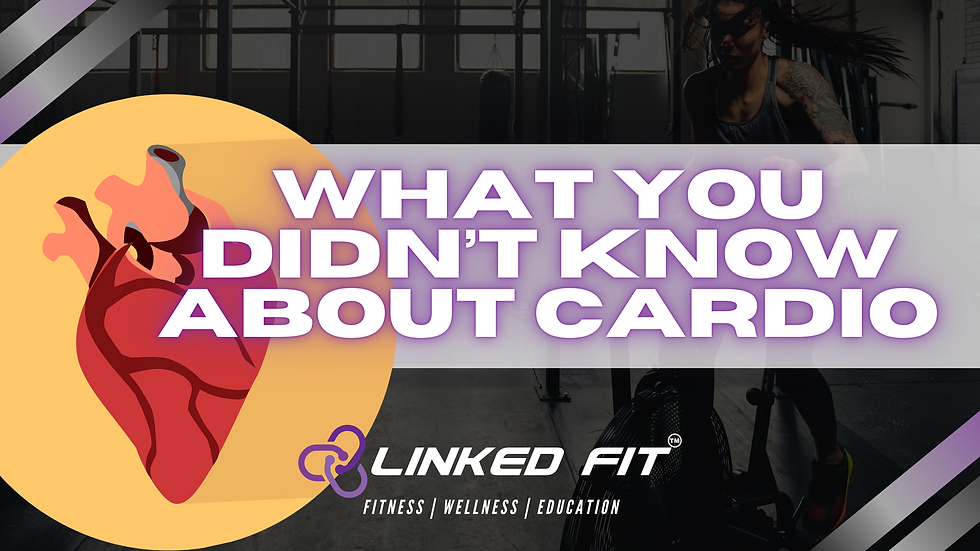Post-Training Protocol: Breathing
- Linked Fit

- Dec 18, 2019
- 7 min read
Updated: May 23, 2022

Breathing should be integrated post-training to produce the advantages of a parasympathetic response!
As many know, following a training program elicit's a response that triggers an adaptation for the greater good! As this response triggers a metabolic edge on physiological and psychological changes, one must determine a plan of action to remind oneself that recovery is superior for these adaptations to occur. Once the primary lifting has been completed, how does one plan to return the body to homeostasis? Oh, I know, it's likely something you haven't thought about. But, this is absolutely okay! Keep reading and see how post-training breathing can help produce the adaptative outcomes and performance you desire!
Following a training session, the body is going through a whirlwind of physiological counteractions. This includes the redirection of blood flow to the global body, rather than just flowing towards worked muscular. Hormonal productions from the stress that was placed on the body, which include the reduction of cortisol (stress hormone). Additionally, activation of protein synthesis to help dominate the inflammatory response from the micro-tears that occurred in the working muscles. In deeper rationales, the heart rate variability can be significantly impacted by time alterations and power disruptions. As a triggered training response such as increased heart rate, this relates to the allostatic load via sympathetic activation. However, post-training, one needs to focus on parasympathetic activation.
The primary goal of breathing is to regulate the respiratory sinus arrhythmia by terms of regulating the “breathing frequency” during inhalation and exhalation. Watch the quick video below by Coach Alex and see how to administer a slow and controlled breathing frequency.
It's time to breathe!

Ferreira, Tanaka, Santos-Galduróz, and Galduróz (2015) explain that improving the respiratory system can help promote better blood oxygenation and cerebral function. In simple terms, improving the functions of the respiratory system by implementing appropriate breathing frequencies may improve cognitive functions via abstraction and mental flexibility. During training, blood flow is directed towards working muscles to provide the needed ingredients to sustain adequate productivity. Although fatigue is inevitable and eventually will kick in upon intensity considerations of activated tissue, blood flow conversions are essential. At the end of the training, blood flow needs to be distributed appropriately to enhance regeneration from the increased inflammatory responses. Therefore, supervising breathing patterns after a training session will boost parasympathetic stimulation and provide sufficient changes to physiological and psychological domains.
In terms of structural stability of the spine, such as postural control during extremity movements, the diaphragm has been associated with optimizing stabilization during movement and balance among diaphragm thickness. Breathing seems like a simple task but yet, it is a complex motor function that depends on the exquisite coordinated neural activation of a variety of skeletal muscles. The provided information provides evidence that breathing not only can help regulate autonomic functions to drive a parasympathetic state but cognitive function, blood flow direction, and postural control to enhance respiratory function and regenerative characteristics.
HOW DO I BREATHE?
It is recommended to be in a supine position (laying on your back) to regulate positional change and energy expenditure in those positions. Although a supine position is optimal for autonomic regulation, other positions can be utilized in post-training breathing such as sitting or childs-pose. Zaccaro et al. (2018) published a systematic review that focused on slow breathing (any breathing technique under 10 breaths per minute) and the review provides substantial evidence on slow-regulated breathing benefits and the contributions on the cardio-respiratory system. After reviewing the work by Zaccaro et al. (2018), a breathing frequency (respiration rate) of 6 to 10 breaths per minute has shown to be beneficial in increasing parasympathetic activity.
DURATION

Recommendation: 6 to 10 breaths per minute
As mentioned above, after reviewing the work by Lehrer and Gevirtz (2014), Rassler et al. (2018), and Zaccaro et al. (2018), the literature expresses that 6 to 10 breaths per minute can provide substantial changes to the cardio-respiratory system to enhance autonomic recovery, but we still draw the question of how long should breathing should take place. In our opinion, Linked Fit encourages a 2.5 to 5-minute duration while listening to classical or meditation music, and clearing any distraction of background noise is critical. Although we encourage music, some individuals may view it as a distraction, therefore optimize the experience by removing it. The music is meant to be a guide during the breathing process and the goal is to center yourself and return to homeostasis.
CONTROLLED

As mentioned above, it is recommended to be in a controlled position during your breathing. When starting the breathing technique, breathing frequency, respiration mechanics, tidal volume, and inhalation-exhalation ratios are important factors to consider. A slow-paced diaphragmatic breathing technique is recommended to control the regulations of respiratory sinus arrhythmia. The use of a slow-paced breathing technique can be achieved through a variety of methods by inhalation-exhalation-rest ratios. Kniffin et al. (2014), Matthew Edward Brannon Russell, Hoffman, Stromberg, and Carlson (2014), Stromberg, Russell, and Carlson (2015) examined a 4-2-4 breathing ratio and the results suggest it holds a higher effect on HRV high frequency. The high frequency in an HRV recording has been associated with an increased parasympathetic activity. Therefore a 4-2-4 may be an efficient and effective breathing ratio to increase relaxation following a training session.
BREATHING RATIOS

In-Out Ratio:
5-5-x
5 seconds inhalation + 5 seconds exhalation
1 minute = 12 cycles (inhale + exhale)
3-3-x
3 seconds inhalation + 3 seconds exhalation
1 minute = 20 cycles (inhale + exhale)
In-Out-Pause Ratio:
4-2-4
4 seconds inhalation + 2 seconds exhalation + 4 seconds rest
1 minute = 18 cycles (inhale + exhale + rest)
TYPES OF POSITIONS
Now that you have the breathing under control and recommended ratios down, it's time to consider what types of breathing are out there. The types of breathing really play into the position your body is in during the practice of breathing. In this article, we provided three common types of positions we practice here at Linked Fit HQ.
If one experiences low back pain or overall, has a BIG leg training day (i.e. the KPI is a squat or hinge), we recommend the first two videos: 1) Legs on Bench & 2) Straight Leg Elevation. While practicing the breathing ratio, the elevation of the legs can help reduce the pressure on the low back and ultimately help reset the pelvis. Additionally, the elevation will help reduce the extremes of blood flow towards the lower body muscles. Although blood flow is needed for recovery, this helps control the circulatory system for unwanted stress and making it work harder than it needs to.
When it comes to crocodile breathing (the third video), this is a great position to maintain when individuals experienced a focus of upper body training. Additionally, the added pressure of the anterior portions of the body helps strengthen the diaphragm and reduce tension within the thoracic spine. If you have restrictions on rotating the upper body via the spine, this is a great position to practice post-training.
References:
Amaro-Gahete, F. J., Sanchez-Delgado, G., Alcantara, J. M. A., Martinez-Tellez, B., Acosta, F. M., Merchan-Ramirez, E., . . . R. Ruiz, J. (2019). Energy expenditure differences across lying, sitting, and standing positions in young healthy adults. PloS one, 14(6), e0217029. doi:10.1371/journal.pone.0217029
Barak, O. F., Jakovljevic, D. G., Popadic Gacesa, J. Z., Ovcin, Z. B., Brodie, D. A., & Grujic, N. G. (2010). Heart rate variability before and after cycle exercise in relation to different body positions. Journal of sports science & medicine, 9(2), 176-182. Retrieved from http://search.ebscohost.com/login.aspx?direct=true&AuthType=ip,shib&db=s3h&AN=52291882&site=ehost-live&custid=ns015031
Bolea, J., Pueyo, E., Orini, M., & Bailón, R. (2016). Influence of Heart Rate in Non-linear HRV Indices as a Sampling Rate Effect Evaluated on Supine and Standing. 7. doi:10.3389/fphys.2016.00501
Ferreira, L., Tanaka, K., Santos-Galduróz, R. F., & Galduróz, J. C. F. (2015). Respiratory training as strategy to prevent cognitive decline in aging: a randomized controlled trial. Clinical interventions in aging, 10, 593-603. doi:10.2147/CIA.S79560
Fogarty, M. J., Mantilla, C. B., & Sieck, G. C. (2018). Breathing: Motor Control of Diaphragm Muscle. Physiology, 33(2), 113-126. doi:10.1152/physiol.00002.2018
Green, D. J., Hopman, M. T. E., Padilla, J., Laughlin, M. H., & Thijssen, D. H. J. (2017). Vascular Adaptation to Exercise in Humans: Role of Hemodynamic Stimuli. Physiological Reviews, 97(2), 495-528. doi:10.1152/physrev.00014.2016
Hodges, P. W., Heijnen, I., & Gandevia, S. C. (2001). Postural activity of the diaphragm is reduced in humans when respiratory demand increases. 537(3), 999-1008. doi:10.1111/j.1469-7793.2001.00999.x
Kniffin, T. C., Carlson, C. R., Ellzey, A., Eisenlohr-Moul, T., Beck, K. B., McDonald, R., & Jouriles, E. N. (2014). Using Virtual Reality to Explore Self-Regulation in High-Risk Settings. Trauma, Violence, & Abuse, 15(4), 310-321. doi:10.1177/1524838014521501
Kocjan, J., Gzik-Zroska, B., Nowakowska, K., Burkacki, M., Suchoń, S., Michnik, R., . . . Adamek, M. (2018). Impact of diaphragm function parameters on balance maintenance. PloS one, 13(12), e0208697-e0208697. doi:10.1371/journal.pone.0208697
Lehrer, P. M., & Gevirtz, R. (2014). Heart rate variability biofeedback: how and why does it work? Frontiers in psychology, 5, 756-756. doi:10.3389/fpsyg.2014.00756
Lewis, M. J., Kingsley, M., Short, A. L., & Simpson, K. (2007). Rate of reduction of heart rate variability during exercise as an index of physical work capacity. Scandinavian Journal of Medicine & Science in Sports, 17(6), 696-702. doi:10.1111/j.1600-0838.2006.00616.x
Nicolas, M., Vacher, P., Martinent, G., & Mourot, L. (2019). Monitoring stress and recovery states: Structural and external stages of the short version of the RESTQ sport in elite swimmers before championships. Journal of Sport and Health Science, 8(1), 77-88. doi:10.1016/j.jshs.2016.03.007
Plans, D., Morelli, D., Sütterlin, S., Ollis, L., Derbyshire, G., & Cropley, M. (2019). Use of a Biofeedback Breathing App to Augment Poststress Physiological Recovery: Randomized Pilot Study. JMIR Formativ Res, 3(1), e12227. doi:10.2196/12227
Rassler, B., Schwerdtfeger, A., Aigner, C. S., & Pfurtscheller, G. (2018). "Switch-Off" of Respiratory Sinus Arrhythmia Can Occur in a Minority of Subjects During Functional Magnetic Resonance Imaging (fMRI). Frontiers in physiology, 9, 1688-1688. doi:10.3389/fphys.2018.01688
Ribeiro, M. K. A., Alcântara-Silva, T. R. M., Oliveira, J. C. M., Paula, T. C., Dutra, J. B. R., Pedrino, G. R., . . . Rebelo, A. C. S. (2018). Music therapy intervention in cardiac autonomic modulation, anxiety, and depression in mothers of preterms: randomized controlled trial. BMC psychology, 6(1), 57-57. doi:10.1186/s40359-018-0271-y
Russell, M. E. B., Hoffman, B., Stromberg, S., & Carlson, C. R. (2014). Use of Controlled Diaphragmatic Breathing for the Management of Motion Sickness in a Virtual Reality Environment. Applied Psychophysiology And Biofeedback, 39(3), 269-277. doi:10.1007/s10484-014-9265-6
Russell, M. E. B., Scott, A. B., Boggero, I. A., & Carlson, C. R. (2016). Inclusion of a rest period in diaphragmatic breathing increases high frequency heart rate variability: Implications for behavioral therapy. doi:10.1111/psyp.12791
Sorensen, J. R., Kaluhiokalani, J. P., Hafen, P. S., Deyhle, M. R., Parcell, A. C., & Hyldahl, R. D. (2019). An altered response in macrophage phenotype following damage in aged human skeletal muscle: implications for skeletal muscle repair. The FASEB Journal, fj.201900519R. doi:10.1096/fj.201900519R
Stromberg, S. E., Russell, M. E., & Carlson, C. R. (2015). Diaphragmatic breathing and its effectiveness for the management of motion sickness. Aerosp Med Hum Perform, 86(5), 452-457. doi:10.3357/amhp.4152.2015
Wehrwein, E., Orer, H. S., & Barman, S. (2016). Overview of the Anatomy, Physiology, and Pharmacology of the Autonomic Nervous System. In (Vol. 6, pp. 1239-1278).
Zaccaro, A., Piarulli, A., Laurino, M., Garbella, E., Menicucci, D., Neri, B., & Gemignani, A. (2018). How Breath-Control Can Change Your Life: A Systematic Review on Psycho-Physiological Correlates of Slow Breathing. Frontiers in human neuroscience, 12, 353-353. doi:10.3389/fnhum.2018.00353




Comments